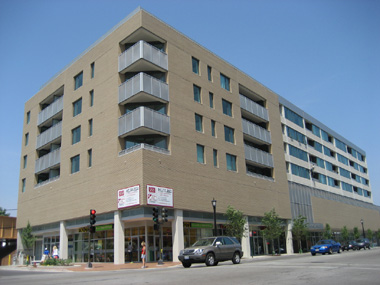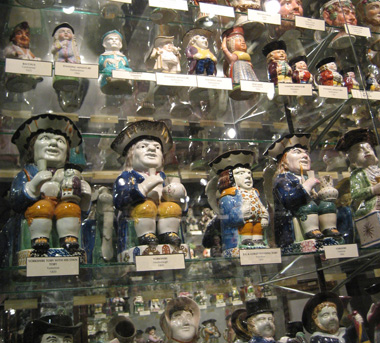"Another high-rise." In Evanston, those words usually come with a sigh of resignation or a resentful grumble. Of the city's 10 tallest buildings, five are condos built within the last five years. People here tend to think that gentrification — evil, vile gentrification — is spreading monotony over civilization like a giant butter knife, burying culture and character under a bland smear that will eventually run from city centers to remote exurbs. The small shop owner with the late-19th-century storefront feels himself in danger — so maybe he should get into the condo business himself.
Kevin Pearson and Steve Mullins have done just that. The owners of a mail-order antiques business and the American Toby Jug Museum since 1995, the two started looking at a new location across the street from their old storefront, on Chicago Avenue near Main Street in Evanston, in 2001. They partnered with Chicago firm Matthews Development to build 900 Chicago, a 77-condo low-rise with retail and office space, and opened the new storefronts to certain businesses already in the neighborhood, including their own. Several of the building's retail tenants moved in from a building at 845 Chicago Ave., catty-corner to the building, that may eventually be razed to make space for another condo project.

The 900 Chicago Building
The result is probably the only new condo building in the world with an antiques museum in its basement. It's proudly advertised on the ground floor as the world's largest private collection of Toby jugs — combination beer vessels and figurines that originated in 18th Century Britain. If character is the aim and incongruity makes for character, this is an improvement. "Chicago Avenue has never been particularly pleasant and attractive," Pearson says. That's especially true at this intersection, where the clutter and dust of construction is just now clearing away from projects including 900 Chicago. The night Pearson held the grand opening for the new museum last fall, the Chicago Transit Authority slammed a new steel bridge into place over Main Street, replacing a crumbling stone viaduct on the Purple Line's route. The bridge was built on-site — in the middle of Main Street — last summer.
The 900 Chicago project didn't start out pretty either. Pearson and Mullins originally intended to build a smaller, 14-unit project when they bought the former Great Bank Evanston building at the intersection of Main and Chicago. "We took a million dollar building [and] spent a quarter million to virtually destroy it [and] create a half-million dollar building," Pearson said. At that point, the old building's foundations turned out to be weaker than thought, and the two started looking for a partner. They ended up with Robert Matthews of Chicago's Matthews Development, who snapped up extra lots north of the bank building and scaled up the project. Matthews has effectively given Pearson and Mullins control over the building's retail space. So far, about 70 percent of the condos have been sold, and two retail spaces are unoccupied.
"It's a lot easier to think about being a good neighbor if you know you're going to be a neighbor for the foreseeable future," Pearson says. Ideally, 900 Chicago will protect some of the neighborhood's esoteric elements. Pearson is open to major retailers, but doesn't want to bring in anything that will compete with, say, Dave's Down-to-Earth Rock Shop and Prehistoric Life Museum, or Cross-Rhodes, a small Greek restaurant beloved for its gyros and seasoned French fries. The prized corner space went to Froots, a small chain that serves wraps and fruit smoothies. A friend of Pearsons' opened up Brazilian Soul, an eclectic women's clothing store. "It's a new building, [and it] smells better," says Bert Shlimon, who moved his business, Main Street Cleaners and Evanston Tux, from 845 Chicago to a space on the east side of the 900 building. He's been in the neighborhood for 14 years. "Rent-wise it's more expensive for sure," but Shlimon thinks it's worth paying it to have more window space.
Call it development realpolitick. Small businesses may just have to help themselves and each other if they're to survive in gentrifying areas. Developers have learned time and again that Evanston's officials may hassle them on some details, but in the end won't turn away the revenue that new condo towers and retail centers promise. And those developers often prefer national retailers because "if the store goes broke, they still pay the rent," says Larry Widmayer, a commercial real-estate agent for Koenig & Strey and a member of Evanston's Plan Commission. But Main Street's small-business clusters are much easier to protect than those downtown in the first place. Widmayer says commercial rents on Main are relatively stable because small businesses tend to stay there long-term. Widmayer rarely gets clients looking for space on Main — and when he does, there's nothing available there, he says.

The American Toby Jug Museum
The Plan Commission, which advises Evanston's city officials on development matters, has been looking for ways to promote small businesses in Evanston's downtown (about a mile north of the Main Street district). One option is what Widmayer calls "The old Chrysler bailout approach" — assuring property owners that the city will come up with rent if small commercial tenants don't. Commercial rents in some areas of downtown have increased by as much as 50 percent in the past eight years, though some areas, such as the stretch of Davis Street west of the Metra tracks, remain dotted with locally owned businesses.
"It's inevitable in Evanston that development's gonna happen," says Chris Casas, owner of the Italian Coffee Bar, a coffee shop at the intersection of Sherman Avenue and Grove Street, on the south edge of downtown Evanston. Casas is opening up a third location (his second is in Highland Park) in what used to be a Marble Slab Creamery. He'll be right between an American Apparel and a Noodles & Co. in Church Street Plaza, a glossy downtown retail development that centers around an 18-screen movie theater and a few chic shops and restaurants, including a Wolfgang Puck's Café and an Urban Outfitters. Until Casas moves in, it will be one of the few parts of downtown without a proper coffee shop (unless one counts the Borders across the street, which serves mediocre coffee and doesn't open early enough for commuters boarding at the nearby Chicago Transit Authority and Metra stations).
From Casas' Sherman Avenue location, one can see Sherman Plaza, a hulking condo-retail project nearing completion after years of bureaucratic wrangling. It's going to open ready-made with a Pier 1 Imports, an Ann Taylor Loft and an Elizabeth Arden Red Door Spa, to name a few. This might look intimidating to a small-business owner, but it also raises the question of why people value small businesses. Don't we demand from them what we demand from national chains — stuff we need and/or stuff we can't get anywhere else? Instead of trying to fight off development through acquiescent and cash-strapped city councils, maybe locals should just hand it to the businesses, local or not, that adapt to the times and deliver more than just the elusive good known as "local character."





